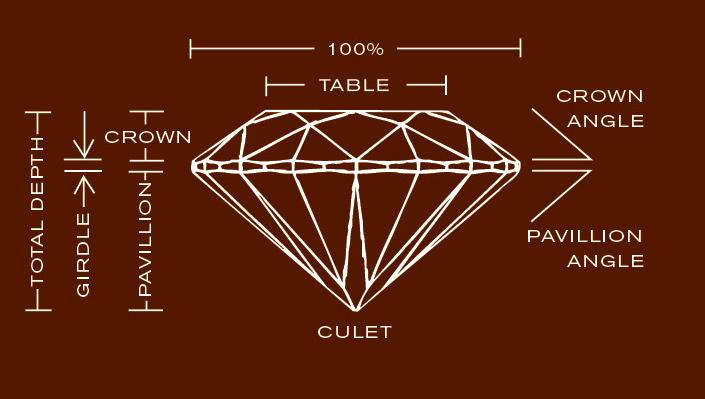Diamond Cut Grade is a key factor in determining a diamond’s overall beauty and value. It assesses how well a diamond has been shaped and faceted to maximize its ability to reflect light, creating brilliance and sparkle. A diamond’s cut grade is different from its shape (such as round, square, or oval) because it refers specifically to the quality of the craftsmanship involved in shaping and faceting the stone.
The Key Elements of Diamond Cut Grade:
Proportions:
The proportions of the diamond include the ratio of the table size (top flat surface), depth (the height of the diamond), and the girdle (the outer edge). These proportions must be balanced to ensure that light can enter, reflect, and exit the diamond optimally.
Symmetry:
Symmetry refers to how well the facets are aligned and arranged. Proper symmetry allows light to reflect evenly across the surface of the diamond, contributing to its brilliance.
Finish:
Finish refers to the quality of the polishing process. The finer the polish, the more light the diamond can reflect, enhancing its sparkle.
Diamond Cut Grades:
The cut grade can range from Excellent to Poor based on how well the diamond’s proportions, symmetry, and finish meet the ideal criteria. The scale used by most grading labs, including DCLA, is as follows:
Excellent Cut:
Diamonds with an Excellent Cut are considered the best. These diamonds reflect light in the most brilliant and dazzling way.
They have precise proportions, ideal symmetry, and a flawless polish, maximizing the sparkle and brilliance.
Ideal for: Those seeking the best possible appearance in terms of light performance.
Very Good Cut:
A Very Good Cut diamond reflects almost as much light as an Excellent Cut diamond, with only slight imperfections in the proportions or symmetry.
These diamonds still exhibit excellent brilliance, but may lack the extreme precision of an Excellent Cut.
Ideal for: Those who want a high-quality diamond at a slightly more affordable price point.
Good Cut:
A Good Cut diamond has visible differences in proportions, which can affect the diamond’s light reflection, but it still looks attractive with decent sparkle.
These diamonds may not exhibit the same level of brilliance as the top grades, but they offer good value.
Ideal for: Budget-conscious buyers who still want a well-cut diamond.
Fair Cut:
A Fair Cut diamond has more noticeable issues with proportions and symmetry that can reduce its ability to reflect light.
While still a diamond, it may appear less brilliant and duller than diamonds with higher cut grades.
Ideal for: Those seeking a lower-priced diamond, though it may not be the best in terms of light performance.
Poor Cut:
A Poor Cut diamond exhibits significant issues with proportions, symmetry, or polish, leading to poor light reflection and diminished brilliance.
The sparkle and fire are significantly reduced compared to higher-grade diamonds.
Ideal for: Typically, diamonds graded as Poor Cut are not recommended for purchasing, as they do not offer good visual appeal.
Factors That Influence Diamond Cut Grade:
Table Size: The table is the flat top facet of the diamond. If it’s too large or too small, it can affect the diamond’s brilliance.
Ideal Table Size: Typically between 53%-58% of the total diameter of the diamond.
Depth: The depth is the height of the diamond from the table to the culet. The depth percentage is the ratio of the diamond’s depth to its diameter.
Ideal Depth: Between 59%-62.5%.
Crown Angle: The crown is the upper portion of the diamond above the girdle. The crown angle influences how light is reflected from the diamond.
Ideal Crown Angle: Typically between 34-35 degrees for round brilliant cuts.
Pavilion Angle: The pavilion is the lower part of the diamond beneath the girdle. The pavilion angle helps determine how well the diamond reflects light.
Ideal Pavilion Angle: Around 40.6-41.2 degrees for round brilliant diamonds.
Girdle Thickness: The girdle is the outer edge of the diamond, and it should neither be too thin nor too thick.
Ideal Girdle Thickness: Neither too thin nor too thick, which allows for proper durability and light reflection.
Symmetry: Symmetry refers to how well the diamond’s facets match and align. Good symmetry ensures consistent light reflection and enhances the overall sparkle of the diamond.
Polish: The finish or smoothness of the diamond’s facets affects how light travels and reflects. A smooth and well-polished diamond reflects more light and appears more brilliant.
The Role of Cut in Diamond Value:
Cut is the most important factor in a diamond’s appearance. While colour, clarity, and carat weight are important, a poorly cut diamond will not appear as brilliant as a well-cut diamond, regardless of its other attributes.
A diamond’s cut grade can significantly impact its price. Diamonds with Excellent or Ideal cuts are typically more expensive due to their superior light performance and visual appeal.
DCLA’s Diamond Cut Grading:
The Diamond Certification Laboratory of Australia (DCLA) follows the international cut grading standards and provides a detailed analysis of a diamond’s cut, including the table size, depth, crown and pavilion angles, symmetry, and finish.
DCLA uses advanced gemological tools to measure and grade diamonds with precision, ensuring that each diamond receives an accurate and reliable cut grade.
